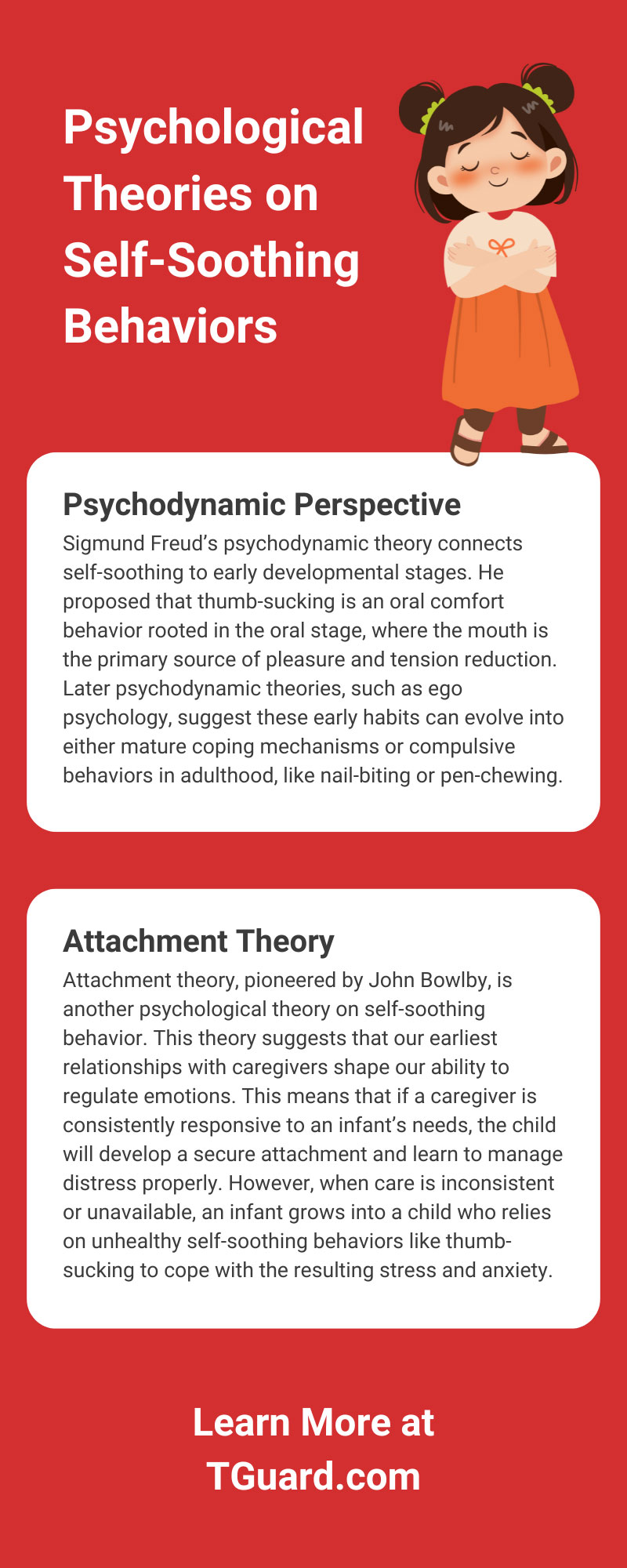When life feels overwhelming, we all have personal ways to find comfort and calm. It’s a natural human instinct to seek out small actions or moments that help us reset and manage feelings of stress or unease. Everyone develops their own unique set of behaviors to soothe themselves, whether through conscious choice or automatic habit. These actions, ranging from an infant’s thumb-sucking to an adult’s deep breathing, are fundamental to our ability to regulate stress. Discover some of the psychological theories related to self-soothing behaviors.
What Is Self-Soothing?
Self-soothing is the practice of using behaviors or activities to calm yourself during times of stress or emotional discomfort. It involves intentionally engaging in actions that promote peace and stability without depending on others. Nearly all of us naturally exhibit this at birth by sucking our thumbs or fingers, which helps us feel safe and secure. Over time, we develop various methods of self-soothing, which are detailed below.
- Taking slow, deep breaths
- Listening to calming music or nature sounds
- Wrapping yourself in a weighted or heavy blanket
- Engaging in a grounding exercise (e.g., the 5-4-3-2-1 method)
- Sipping a warm, non-caffeinated drink like herbal tea
- Engaging in a mindful hobby, such as knitting, drawing, or gardening
- Gentle stretching or yoga
- Taking a warm bath or shower
- Practicing positive self-talk or repeating a calming mantra
What’s interesting about self-soothing habits is that the more we do them, the more control we have over our emotional state. By actively engaging in these practices, we train our brains to associate them with a sense of calm and safety.
Psychological Theories Explaining Self-Soothing
Psychology offers a deeper understanding of why we all engage in self-soothing behaviors; however, there is no single reason, meaning that each theory has its own unique perspective. Each theory offers a distinct perspective through which to view these fundamental human actions.
Psychodynamic Perspective
Sigmund Freud’s psychodynamic theory connects self-soothing to early developmental stages. He proposed that thumb-sucking is an oral comfort behavior rooted in the oral stage, where the mouth is the primary source of pleasure and tension reduction. Later psychodynamic theories, such as ego psychology, suggest these early habits can evolve into either mature coping mechanisms or compulsive behaviors in adulthood, like nail-biting or pen-chewing.
Attachment Theory
Attachment theory, pioneered by John Bowlby, is another psychological theory on self-soothing behavior. This theory suggests that our earliest relationships with caregivers shape our ability to regulate emotions. This means that if a caregiver is consistently responsive to an infant’s needs, the child will develop a secure attachment and learn to manage distress properly. However, when care is inconsistent or unavailable, an infant grows into a child who relies on unhealthy self-soothing behaviors like thumb-sucking to cope with the resulting stress and anxiety.
Behavioral and Learning Theories
Theories of behavioral and learning psychologists suggest that self-soothing behaviors stem from reinforcement and observation. An infant who sucks their thumb and experiences a stress reduction is likely to repeat the behavior, conditioning it as a go-to coping strategy. Children also learn by observing others, often imitating the self-soothing habits of their parents or caregivers, which models how to manage emotional states.
Cognitive-Behavioral Perspective
The cognitive-behavioral perspective focuses on the interplay between thoughts, feelings, and behaviors. Thumb-sucking provides immediate relief from anxiety, which reinforces the behavior and makes it more likely to occur in the future. As a child matures, they can learn more adaptive cognitive-behavioral strategies, such as deep breathing, grounding techniques, or positive self-talk, to replace these early habits.
Neurobiological Perspective
A neurobiological viewpoint explains self-soothing through its effects on the nervous system. Repetitive, rhythmic actions, such as thumb-sucking, can activate the parasympathetic nervous system, which is responsible for the body’s “rest and digest” response. This activation triggers the release of calming neurochemicals, such as endorphins, which effectively reduce heart rate and promote a sense of calm.
Mindfulness and Emotion Regulation Theories
Modern emotion regulation theories view early self-soothing as a primitive form of mindfulness. The focused, repetitive nature of an action like thumb-sucking helps an infant manage overwhelming sensory input and calm their mind. In adulthood, this same impulse can evolve into sophisticated mindfulness practices, such as meditation, sensory engagement, or guided imagery.
Evolutionary Perspective
The evolutionary perspective posits that self-soothing behaviors are adaptive mechanisms that promote survival and well-being. By helping an infant cope with stress and regulate their emotional state, these behaviors allow them to conserve energy and endure periods of discomfort. This capacity for self-regulation signals resilience and contributes to the infant’s overall well-being.
The Role of Thumb-Sucking in Self-Soothing
Thumb-sucking is often one of the first and most prominent self-soothing behaviors to emerge. Its function and form evolve significantly as an individual moves from infancy through adulthood. Below, we’ve detailed how thumb-sucking impacts self-soothing for the major age groups.
Infancy and Early Childhood
During infancy, thumb-sucking serves as a primary self-soothing mechanism, helping babies manage a wide range of stressors, including hunger, discomfort, and anxiety. People often engage in this behavior alongside other rhythmic actions, such as rocking or cuddling a soft object, to further enhance the calming effect. It provides a reliable source of comfort when external support from a caregiver is not immediately available.
Later Childhood and Adolescence
As children grow, thumb-sucking typically diminishes; however, in some cases, the habit persists into later childhood. Persistent thumb-sucking at this stage is generally recognized as unhealthy because it can interfere with dental development, speech patterns, and social confidence.
For many children, however, the need to self-soothe shifts into alternative behaviors such as nail-biting, lip-biting, or hair-twirling. Whether through continued thumb-sucking or replacement habits, the underlying drive remains the same: finding a physical outlet to manage internal tension and anxiety during a challenging time.
Adulthood
In adulthood, the impulse to self-soothe continues, often in more socially acceptable or discreet ways such as chewing gum, tapping fingers, or using stress-relief tools. These behaviors are extensions of the same psychological mechanism established in early childhood.
In rare cases, some adults may continue thumb-sucking. While it can provide temporary comfort, persistent thumb-sucking in adulthood can be maladaptive, as it may interfere with dental health, professional appearance, or social relationships. This highlights the importance of finding healthier, age-appropriate strategies to meet the same fundamental need for emotional regulation.
Break The Habit
Understanding self-soothing is the first step toward building a toolkit of healthy emotional regulation strategies. From simple breathing exercises to engaging hobbies, the methods we use to find calm are vital for our overall well-being. Teaching your child healthy coping skills early on lays the foundation for resilience later in life.
Devices such as TGuard’s Aerofinger offer a simple way to stop finger sucking by removing the suction, which eliminates the pleasure factor. By implementing this tool, your child will naturally lose interest in thumb sucking, and you can help them find positive alternatives. Every small step toward healthier coping helps lay the foundation for a lifetime of emotional strength.




